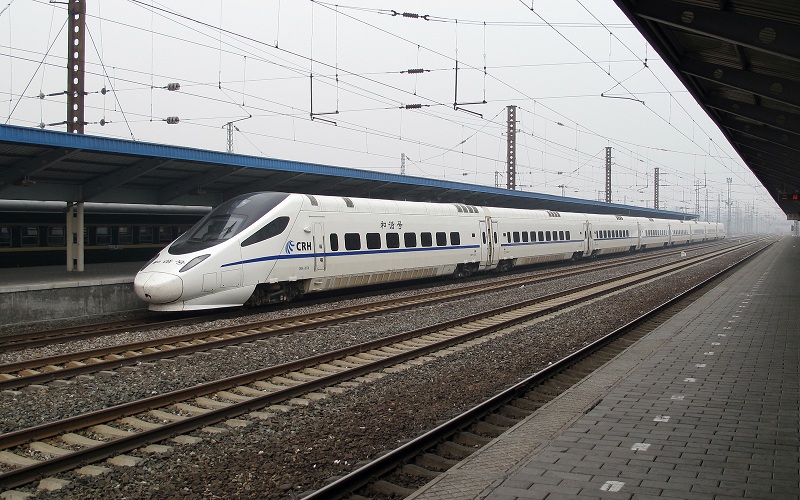Moscow and Beijing are considering building a high-speed freight and passenger rail network that, if constructed, will become the world’s largest railway project. The line, expected to be completed by 2026, would span all of Eurasia and bridge China and Europe by just 20 hours.
The 9,447 km (5,870 mi) line would start in Urumqi in northwestern China; pass through Astana, Kazakhstan; Moscow; Minsk, Belarus; and Berlin.
“The Eurasia high-speed railway initiative is not a one-off project, but the continuation of the Chinese ‘One Belt, One Road’ strategy,” Russian transportation expert Sergey Lomanov told Caspian News, referring to China’s mega-transportation project of overland and sea lanes that aims to connect all corners of the world and speed up global commerce.
Russia’s Ministry of Transport offered to undertake a feasibility study, and pegged the project’s total cost to around $121 billion. Nearly $62 billion of that amount would be needed for the Russian segment, which will pass from Krasnoye station in Russia’s Smolensk region, lying along Russia’s border with Belarus, to Zolotaya Sopka station in the Chelyabinsk region, near Russia’s border with Kazakhstan.
The Russian proposal has been submitted to the governments of Belarus, Kazakhstan and China for consideration. The chief engineer of Belarusian Railways, Valeriy Shubaderov, confirmed that Russian Railways has asked Belarusian Railways to join in the feasibility study.
Russian Railways has already signed a document with Kazakhstan’s Temir Zholy national railway company for the joint development of the Trans-Eurasian corridors, setting up joint ventures that would promote new transportation and logistics services. The railways of Germany, Poland, Belarus, Russia, Kazakhstan and China also signed an agreement on the creation of a high-speed transport corridor Eurasia, connecting Berlin in Europe and Urumqi in China.
Russian Railways is planning to start the construction of the high-speed railway for passenger traffic in 2018 and complete it by 2023. Freight transportation services are not expected to begin until 2026. By 2050, officials forecast that the line will move 20 million tons of cargo and almost 37 million passengers annually.
The project’s developers estimate that the line will result in 10 to 15 percent of the goods traded between China and the European Union to travel overland. Currently that figure is only two percent, and projected to reach as high as 3.5 percent by this year’s end. Goods shipped by sea from China to Europe currently require at least a month.
“The Eurasia high-speed railway is to compete against cargo transportation by air, which is costly, and often customers cannot afford it. Customers expect to receive the goods they order online, for example, within three to five days,” Sergey Lomanov said, explaining how the rise of e-commerce over the past decade has impacted the assessment for building a high-speed railway.
E-commerce between the countries of Asia and Europe, including Russia, has grown at double-digit rates annually. By 2020, the volume of e-commerce is expected to be over $4 trillion worldwide, according to Lomanov.
“The high-speed railway will deliver cargo at a speed of up to 300 km/h and is the best option for the transporting of e-commerce goods, whose volumes have recently growing at an impressive rate. In the long term, this will allow for deliveries going from China to Europe to take, on average, over three days,” Lomanov said.
While China, Kazakhstan and Belarus are reviewing the details, Russia has pushed ahead with its portion.
Work has already begun on the Moscow-Kazan segment, which will measure 770 km (479 mi) once its complete and be one of the biggest infrastructure projects ever undertaken in the country. Expected to serve 25 million Russians throughout seven regions, the route will cut travel time between the two Russian cities from 14 to 3.5 hours.
The Moscow-Kazan segment alone is estimated to cost around $16.9 billion, and will get 60 percent of its investment from Russian Railways. The remaining 40 percent is to be financed through foreign investments, including from China, which is providing Russia with a loan for about $6.2 billion, according to reports by TASS news agency.
According to Russian Railways, a number of institutions can provide funding for the Eurasia project, including the Silk Road Fund, BRICS Bank (The New Development Bank), Eurasian Development Bank, Russian Direct Investment Fund (RDIF) and the Russian-Chinese Investment Fund.







 Armenian sappers commenced on Monday mine-clearance operations in the territories adjacent to the Saint Mary Church in village of Voskepar (Armenia...
Armenian sappers commenced on Monday mine-clearance operations in the territories adjacent to the Saint Mary Church in village of Voskepar (Armenia...
 The Mine Action Agency of Azerbaijan (ANAMA) reported on Thursday the discovery of a significant amount of explosives in the Khojavand district of ...
The Mine Action Agency of Azerbaijan (ANAMA) reported on Thursday the discovery of a significant amount of explosives in the Khojavand district of ...
 Iran’s Foreign Minister, Hossein Amir-Abdollahian, has labeled a foiled Israeli drone attack in certain parts of the country as a "failure" for Isr...
Iran’s Foreign Minister, Hossein Amir-Abdollahian, has labeled a foiled Israeli drone attack in certain parts of the country as a "failure" for Isr...
 Iran has refuted reports of alleged damage to Shimon Peres Negev Nuclear Research Centre located southeast of Dimona, Israel, during the recent air...
Iran has refuted reports of alleged damage to Shimon Peres Negev Nuclear Research Centre located southeast of Dimona, Israel, during the recent air...



